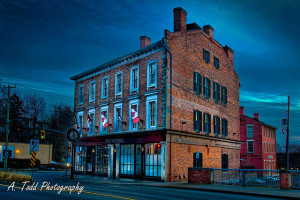 Overlooking Port Hope’s Ganaraska River and park, The Waddell Hotel anchors Historic Port Hope’s Heritage Business District. Only an hour east of Toronto on the shoreline of Lake Ontario, the picturesque town of Port Hope nestles in the valley of the Ganaraska River.
Overlooking Port Hope’s Ganaraska River and park, The Waddell Hotel anchors Historic Port Hope’s Heritage Business District. Only an hour east of Toronto on the shoreline of Lake Ontario, the picturesque town of Port Hope nestles in the valley of the Ganaraska River.
Settled in 1793, Port Hope is well-known for fine early architecture and more than 200 private residences throughout the town have been heritage designated by proud owners. The very popular annual Port Hope House Tour draws thousands each October.
There’s always something to do in the historic town. The town’s Capitol Theatre is a very popular venue as are our many antique and specialty shops, galleries, cafes, pubs and restaurants which draw thousands of tourists each year.
When The Waddell was built in 1845, it was one of the first large brick buildings built on the main street. Port Hope’s prosperous era, which was to last for about thirty years, was just the beginning.
The site of The Waddell building was originally an island, since the Ganaraska River at one time divided and also flowed through a swampy area which is now Mill Street. The land was part of the original loyalist land grants received by one of the town’ founders, Elias Smith, for services to the British during the American Revolution, and compensation for the loss of his holdings in New York City.
Sheriff Robert Waddell purchased the land from Elias Smith in 1844 and immediately sought proposals from the two leading Toronto architects of the day – John Howard (noted for building Colborne Lodge in Toronto High Park) and William Thomas who won the competition.
Thomas had recently immigrated after a successful career in England mostly as a church architect. He bid for the Nelson Monument project in London, but was unsuccessful, and shortly afterwards came to Canada. His first commission was for The Commercial Bank of the Midland District erected on Wellington Street, Toronto, in 1844. The facade of this building has been preserved in the atrium of BCE Place in Toronto. Three commissions followed in 1845 – St. Michael’s Cathedral and St. Lawrence Hall, both in Toronto, and The Waddell building in Port Hope. Thomas went on to design over one hundred landmark buildings in Canada, many of which are still standing.
The building was designed to include a bank (The Waddell’s Bank of Montreal agency), two retail units facing Walton Street and a hotel on the upper floors. The bank faced Mill Street (where the present lobby is located) and the entrance was flanked by massive stone columns to impress patrons and project the image of a strong, reliable bank. The bank manager was housed in quarters above the bank. The hotel lobby was in a room located near the fireplace in the present dining room. A stairway led to the hotel rooms above and access to the street was through a hallway to the center door on Walton Street. This entrance was also flanked by stone columns, albeit of less imposing nature than those of the bank. A massive bake oven was located in the basement.
The building features prominent chimneys, parapet end walls, a decorative cornice supported by brackets, and a rooftop cupola or lantern. Second storey windows have been eared architrave with a decorative cornice and the third storey windows are treated in a simpler fashion. Brickwork is of Flemish Bond design with rusticated stone quoins at the corners, one of which shows the building date of 1845. Since the intention was to add an adjacent block immediately to the west (the river was much narrower then), rafter pockets for the next building were built into the west wall. These were filled in with wood temporarily and can still be seen.
James O’Neill was the most prominent retailer to occupy the premises and vestiges of his sign are visible on the west wall.
